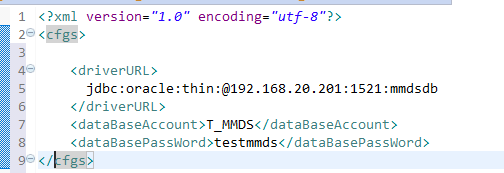本文最后更新于 2370 天前,其中的信息可能已经有所发展或是发生改变。
最近在开发中用的比较多的是xml和properties这两种配置的格式文件,而yml暂时我还真的很少用,就学习spring Boot的时候用过,在现在公司开发小的工具程序都基本上用xml和properties。
但是现在感觉自己更倾向于用properties,但最近也还是在用xml写小程序,可能是习惯来得快?
接下来就写一下xml和properties的区别?也算是2018年最后一篇文章日志了,感谢现在努力的自己
格式写法?
xxx.xml文件格式

xxx.properties文件格式

从这两种图,可以看出xml的结构比properties清晰(yml也是),而properties文件要比.xml文件结构要简单一些。
可能是xml采用树形结构,而properties采用的是键值对的形式?
下面写下读取这配置文件内容的代码吧(代码比较乱勿喷)
- 读取properties文件的代码实现
package com.glj.util;
import java.io.BufferedInputStream;
import java.io.File;
import java.io.FileInputStream;
import java.io.IOException;
import java.io.InputStream;
import java.net.URL;
import java.util.Properties;
import org.apache.commons.lang3.StringUtils;
import org.apache.log4j.Logger;
public class ConfigUtil {
private static final Logger log = Logger.getLogger(ConfigUtil.class);
private static Properties prop = null;
public ConfigUtil(InputStream is) {
prop = new Properties();
try{
BufferedInputStream bis = new BufferedInputStream(is);
InputStream in = bis;
prop.load(in);
}catch (Exception e){
log.error("读取"+prop+"配置文件错误!",e);
}
}
public static void init(String cfgPath) {
String realPath = "";
if(StringUtils.isNotBlank(cfgPath) && new File(cfgPath).exists()) {
realPath = cfgPath;
}else {
String defExistsPath = ClassLoader.getSystemResource("").getPath()+"cfg.properties";
realPath = new File(defExistsPath).exists()? defExistsPath: "";;
}
try{
InputStream is = StringUtils.isNotBlank(realPath)? new FileInputStream(realPath):
ConfigUtil.class.getClassLoader().getResourceAsStream("cfg.properties");
log.info("读取配置文件:"+realPath);
new ConfigUtil(is);
} catch (IOException e1) {
log.error("读取配置文件出错");
}
}
public static String getProperty(String propertyName) {
if(prop == null) {
ConfigUtil.init("");
}
if("".equals(propertyName) || null==propertyName) {
return "";
}
return prop.getProperty(propertyName);
}
public static void main(String[] args) {
// String path = ClassLoader.getSystemResource("").getPath()+"log4j.properties";
// ConfigUtil.init(path);
// System.out.println(ConfigUtil.getProperty("log4j.rootLogger"));
System.out.println(ConfigUtil.getProperty("mysql.className"));
}
}
- 读取xml文件的代码实现(基于DOM4J实现方法)
更多的方法可以到这个链接学习:https://www.cnblogs.com/lingyao/p/5708929.html
package com.glj.util;
import java.util.Map;
import org.dom4j.Document;
/**
* Xml文件操作接口
* @author Jiomer
*
*/
public interface XmlSupport {
/**
* 创建xml文件
* @return
*/
public Document createDocument();
/**
* 读xml文件
* @param file
* @return
* @throws Exception
*/
public Map readDocument(String file)throws Exception;
/**
* 写xml文件
* @throws Exception
*/
public void writerDocument() throws Exception;
/**
* 更新xml文件
*/
public void updateDocument() ;
}
package com.glj.util;
import java.io.File;
import java.io.FileInputStream;
import java.io.FileWriter;
import java.util.HashMap;
import java.util.List;
import java.util.Map;
import org.dom4j.Document;
import org.dom4j.DocumentHelper;
import org.dom4j.Element;
import org.dom4j.io.OutputFormat;
import org.dom4j.io.SAXReader;
import org.dom4j.io.XMLWriter;
public class XmlSupportImpl implements XmlSupport {
public Document createDocument() {
// TODO Auto-generated method stub
Document document = DocumentHelper.createDocument();
Element rootElement = document.addElement("root");
Element uploadFileElement = rootElement.addElement("uploadFile");
Element path = uploadFileElement.addElement("path");
path.setText("/Upload/");
Element size = uploadFileElement.addElement("size");
size.setText("10240");
Element type = uploadFileElement.addElement("type");
type.setText("zip,rar,png,jpg,gif");
return document;
}
public void writerDocument() throws Exception {
}
public Map readDocument(String file) throws Exception{
// TODO Auto-generated method stub
Map map = new HashMap();
SAXReader saxReader = new SAXReader();
/**
* 先读入整份XML文档
*/
Document document = saxReader.read(new FileInputStream(new File(file)));
Element root = document.getRootElement();
List list = root.elements();
for(int i=0;i<list.size();i++){
Element ele = (Element) list.get(i);
map.put(ele.getName(), ele.getText());
}
return map;
}
public void updateDocument() {
// TODO Auto-generated method stub
}
}
package com.glj.util;
import java.io.File;
import java.util.Map;
import org.apache.log4j.Logger;
/**
* 系统配置类
* @author Jiomer
*
*/
public class ConfigureUtil {
private static Logger logger = Logger.getLogger(ConfigureUtil.class);
public static ConfigureUtil instance = null;
@SuppressWarnings("rawtypes")
private Map configureMap = null;
public ConfigureUtil() {
String file = ClassLoader.getSystemResource("").getPath()+"cfg.xml";
System.out.println(file);
logger.info("获取了cfg.xml路径:"+file);
try {
configureMap = new XmlSupportImpl().readDocument(file);
} catch (Exception e) {
// TODO Auto-generated catch block
e.printStackTrace();
}
}
public ConfigureUtil(String isHiber) {
String file = this.getClass().getResource("/").getPath()+"cfghiber.xml";
try {
configureMap = new XmlSupportImpl().readDocument(file);
} catch (Exception e) {
// TODO Auto-generated catch block
e.printStackTrace();
}
}
public String getValue(String key) {
return (String) configureMap.get(key);
}
public static ConfigureUtil getInstance(){
if(null== instance ){
synchronized(ConfigureUtil.class){
if(null== instance){
instance = new ConfigureUtil ();
}
}
}
return instance;
}
public static void main(String[] args) {
// System.out.println(new ConfigureUtil().getValue("driverURL"));
}
}
end…




看见代码就头大
涨姿势了,虽然看不懂